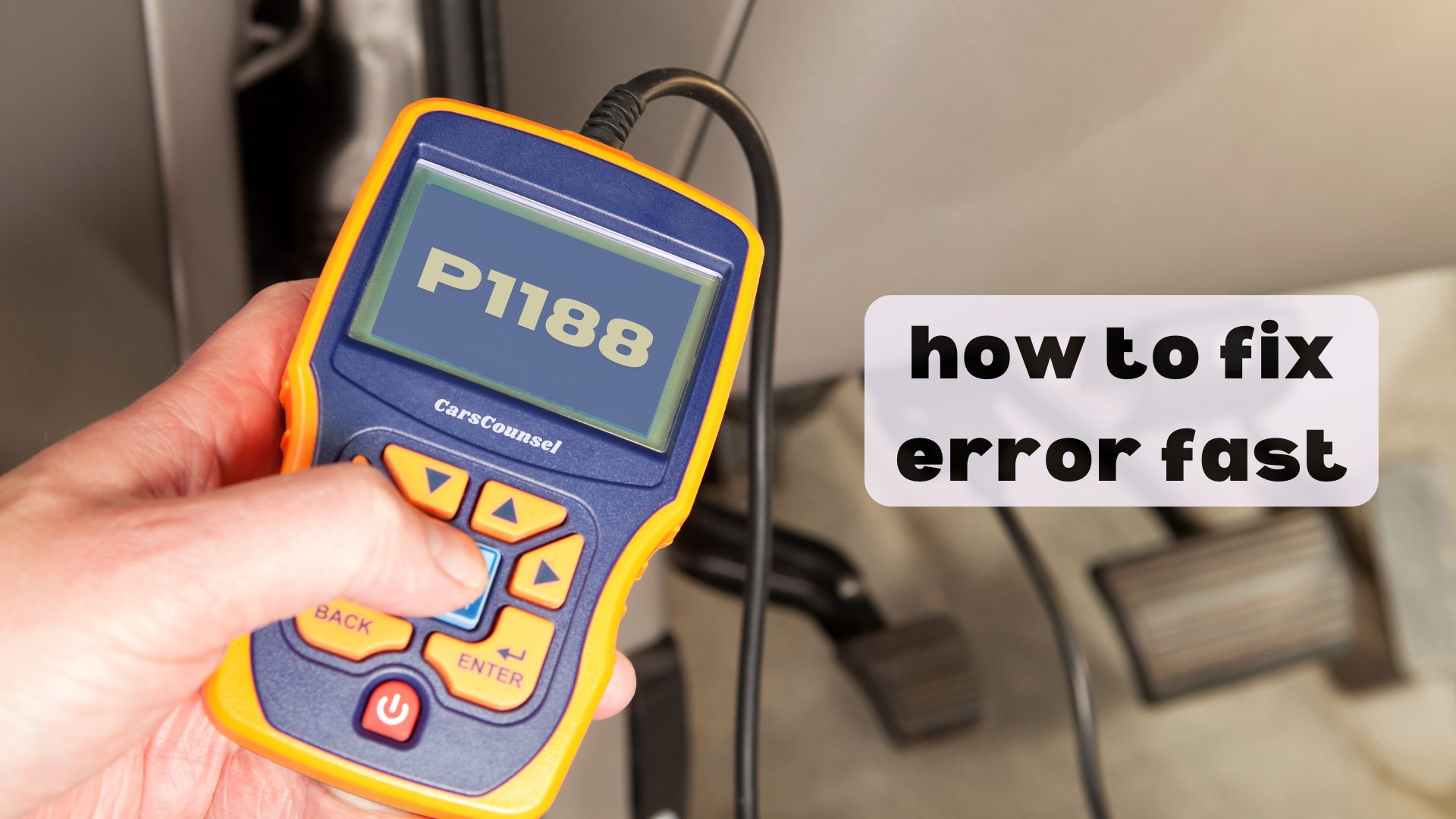When your vehicle’s onboard computer spits out a P1188 code, it’s telling you there’s a fuel pressure monitoring issue related to leakage in the fuel system. This isn’t just a minor hiccup – it can lead to decreased fuel efficiency and overall performance.
But what’s causing the leak? Is it worn fuel system components, corroded fuel lines, or something else entirely? To get to the bottom of the problem, you’ll need to take a closer look at your fuel system.
But don’t worry, we’ll guide you through the process – and by the time you’re done, you’ll be back on the road in no time.

Quick Navigation
Key Takeaways
- The P1188 code indicates a fuel pressure monitoring issue related to leakage in the fuel system, affecting fuel efficiency and engine performance.
- Common causes of fuel pressure leakage include fuel system wear, faulty fuel pressure regulators, worn fuel injector seals, corroded fuel lines, and loose connections.
- Symptoms of a P1188 code include the illuminated check engine light, poor fuel efficiency, rough idling, engine misfires, and difficulty starting the engine.
- A thorough inspection of the fuel system, including visual examination and leak detection methods, is necessary to identify and repair the faulty component.
- Repairing a P1188 code fuel leak typically involves replacing worn or damaged components, tightening loose connections, and clearing the diagnostic trouble code.
Code P1188 Description and Meaning
When your vehicle’s onboard diagnostics system detects a fuel pressure monitoring issue related to leakage, it triggers the P1188 code.
This fault code indicates a problem with the fuel system where fuel pressure isn’t being maintained properly. Fuel pressure is vital for the proper functioning of the engine, ensuring the correct amount of fuel is delivered to the combustion chamber for peak performance.
A leakage issue can have a significant impact on the vehicle’s overall performance and efficiency, affecting fuel efficiency metrics.
The fuel system components, including the fuel pressure regulator, fuel injector seals, fuel lines, and fuel pump, play a pivotal role in maintaining the correct fuel pressure.
Understanding the P1188 code is essential to identifying and addressing the underlying issue to restore peak engine performance.
Common Causes of Fuel Pressure Leakage
As you investigate the P1188 code, it’s clear that identifying the root cause of the fuel pressure leakage is vital to restoring your vehicle’s performance.
You’ll need to pinpoint the source of the issue, which can be attributed to fuel system wear, pressure regulator faults, or other components.
A faulty fuel pressure regulator can lead to inconsistent fuel pressure, while worn fuel injector seals can allow fuel to escape.
Corroded fuel lines, a malfunctioning fuel pump, and loose or damaged fuel system connections are also common culprits.
Symptoms of a P1188 Code
Your vehicle’s performance is suffering, and the check engine light is staring back at you, indicating a P1188 code.
You’re likely experiencing poor fuel efficiency, which is frustrating and costly. Rough or inconsistent idling, engine misfires, and difficulty starting the engine are all common symptoms of a P1188 code.
These issues can significantly impact your vehicle’s overall performance and engine performance optimization. If left unchecked, they can lead to more severe problems down the road.
Diagnosing and Inspecting the Fuel System
You’ll need to perform a thorough inspection of the fuel system to identify the source of the fuel pressure monitoring issue.
This includes a visual examination of the fuel lines, fuel injectors, and fuel pump to look for signs of leakage or damage.
Use leak detection methods such as a fuel pressure test or a smoke test to help pinpoint the exact location of the leak.
Check for loose or damaged connections, corroded fuel lines, and worn fuel injector seals.
A fuel system inspection will help you isolate the faulty component and determine the necessary repairs.
Repairing a P1188 Code Fuel Leak
One faulty component can be the culprit behind a P1188 code fuel leak, and identifying it’s essential to effective repairs.
You’ll need to perform a thorough inspection of the fuel system to locate the source of the leakage. Check for worn fuel injector seals, corroded fuel lines, and malfunctioning fuel pumps.
Tighten or replace any loose or damaged fuel system connections. Replacing faulty components, such as the fuel pressure regulator, can resolve the issue.
Failure to address fuel leak consequences can lead to poor fuel efficiency, engine misfires, and difficulty starting the engine. Regular fuel system maintenance is pivotal to prevent such issues.
Clearing Diagnostic Trouble Codes
Once the faulty component has been replaced and the fuel system is repaired, it’s essential to clear the diagnostic trouble code from the vehicle’s memory to guarantee the check engine light is extinguished and the vehicle returns to normal operation.
You’ll need a scan tool to access the onboard diagnostics (OBD) system and clear the code. Connect the scan tool to the OBD-II port, select the “clear codes” or “erase codes” option, and follow the prompts to complete the process.
Make sure to record the code clearing process for your records. After clearing the code, test drive the vehicle to confirm the issue is resolved and the fuel pressure is within the proper range, and verify that the problem has been fixed.
Cost of Repairing a P1188 Code
The cost of repairing a P1188 code can vary widely, depending on the specific cause of the fuel pressure monitoring issue and the make and model of your vehicle.
| Cost Component | Estimated Cost |
|---|---|
| Parts | $100-$500 |
| Labor | $100-$300 |
| Total | $200-$800 |
You can expect to pay anywhere from $200 to $800 to fix the fuel pressure monitoring leakage issue. The cost of parts can range from $100 to $500, while labor costs can add an additional $100 to $300. It’s essential to get a more accurate estimate from a trusted mechanic, as fuel leak costs can vary depending on the specific repair needed. Remember, these repair estimates are only a rough guide, and your final bill may be higher or lower.
Preventing Future Fuel Pressure Issues
By maintaining your vehicle’s fuel system, you can prevent future fuel pressure issues and avoid costly repairs down the road.
Regular maintenance is key to ensuring your fuel system operates within the proper range. Start by checking your fuel filter regularly and replacing it as needed.
Keep your fuel injectors clean and free of debris. Additionally, inspect your fuel lines and connections for signs of corrosion or damage.
More OBD-II Codes
Frequently Asked Questions
Can I Drive My Vehicle With a P1188 Code?
You can drive your vehicle with a P1188 code, but be cautious: poor fuel economy and potential engine misfires may occur. Take precautions to avoid exacerbating the issue, and plan to have it fixed soon to prevent further damage.
Will a P1188 Code Cause Permanent Engine Damage?
If you ignore the warning signs, you’ll be lucky to escape catastrophic engine damage! A faulty fuel injector can spell disaster for your engine’s performance, but addressing the issue promptly can prevent permanent harm.
Can a Faulty Oxygen Sensor Trigger a P1188 Code?
You’re wondering if a faulty oxygen sensor can trigger a P1188 code. While a malfunctioning O2 sensor can affect sensor accuracy, it’s unlikely to directly cause a fuel pressure monitoring issue, as it doesn’t directly impact fuel efficiency or pressure regulation.
Is a P1188 Code More Common in Certain Vehicle Models?
You’ll notice that certain vehicle models, like those with higher-performance engines or older fuel systems, are more prone to fuel leakage issues, making them more likely to trigger a P1188 code due to model trends and design characteristics.
Can I Repair a P1188 Code Myself Without a Mechanic?
You can attempt a DIY repair with thorough research using DIY repair guides and fuel system diagrams, but without extensive knowledge, it’s recommended to consult a mechanic to avoid exacerbating the issue and guarantee a proper fix.
Conclusion
As you’ve explored into the world of code P1188, you’re now equipped to tackle the fuel pressure monitoring issue head-on. But, beware – a single misstep in diagnosis or repair could lead to catastrophic engine damage. Will you be able to identify the subtle signs of fuel pressure leakage and navigate the complex web of fuel system components to emerge victorious? The fate of your vehicle’s performance hangs in the balance.

